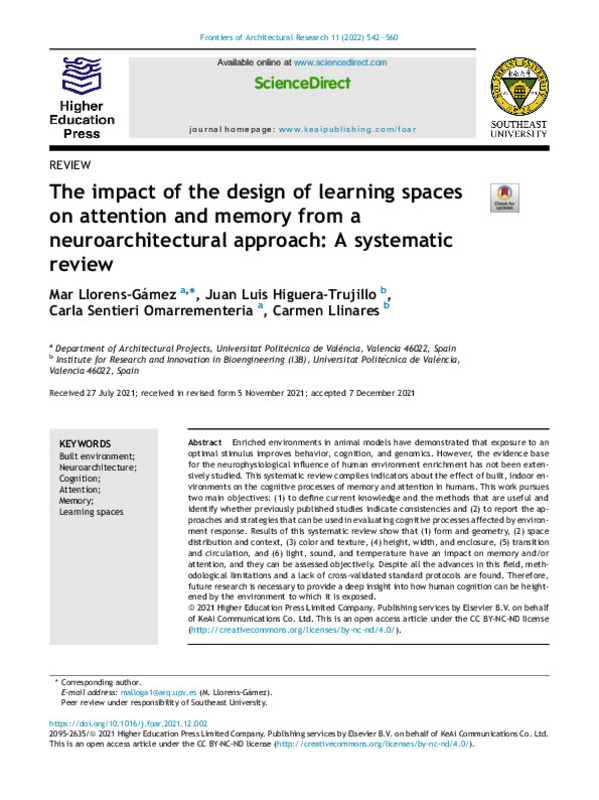JavaScript is disabled for your browser. Some features of this site may not work without it.
Buscar en RiuNet
Listar
Mi cuenta
Estadísticas
Ayuda RiuNet
Admin. UPV
The impact of the design of learning spaces on attention and memory from a neuroarchitectural approach: A systematic review
Mostrar el registro sencillo del ítem
Ficheros en el ítem
| dc.contributor.author | Llorens-Gámez, Mar
|
es_ES |
| dc.contributor.author | Higuera-Trujillo, Juan Luis
|
es_ES |
| dc.contributor.author | Sentieri Omarrementeria, Carla
|
es_ES |
| dc.contributor.author | Llinares Millán, María Del Carmen
|
es_ES |
| dc.date.accessioned | 2023-03-09T19:01:01Z | |
| dc.date.available | 2023-03-09T19:01:01Z | |
| dc.date.issued | 2022-06 | es_ES |
| dc.identifier.uri | http://hdl.handle.net/10251/192470 | |
| dc.description.abstract | [EN] Enriched environments in animal models have demonstrated that exposure to an optimal stimulus improves behavior, cognition, and genomics. However, the evidence base for the neurophysiological influence of human environment enrichment has not been extensively studied. This systematic review compiles indicators about the effect of built, indoor environments on the cognitive processes of memory and attention in humans. This work pursues two main objectives: (1) to define current knowledge and the methods that are useful and identify whether previously published studies indicate consistencies and (2) to report the approaches and strategies that can be used in evaluating cognitive processes affected by environment response. Results of this systematic review show that (1) form and geometry, (2) space distribution and context, (3) color and texture, (4) height, width, and enclosure, (5) transition and circulation, and (6) light, sound, and temperature have an impact on memory and/or attention, and they can be assessed objectively. Despite all the advances in this field, methodological limitations and a lack of cross-validated standard protocols are found. Therefore, future research is necessary to provide a deep insight into how human cognition can be heightened by the environment to which it is exposed. | es_ES |
| dc.description.sponsorship | Grant BIA2017-86157-R was funded by MCIN/AEI/10.13039/501100011033 and by ERDF, A way of making Europe. Grant PRE2018-084051 was funded by MCIN/AEI/10.13039/501100011033 and by ESF, Investing in your future. | es_ES |
| dc.language | Inglés | es_ES |
| dc.publisher | Higher Education Press | es_ES |
| dc.relation.ispartof | Frontiers of Architectural Research (Online) | es_ES |
| dc.rights | Reconocimiento - No comercial - Sin obra derivada (by-nc-nd) | es_ES |
| dc.subject | Built environment | es_ES |
| dc.subject | Neuroarchitecture | es_ES |
| dc.subject | Cognition | es_ES |
| dc.subject | Attention | es_ES |
| dc.subject | Memory | es_ES |
| dc.subject | Learning spaces | es_ES |
| dc.subject.classification | ORGANIZACION DE EMPRESAS | es_ES |
| dc.subject.classification | PROYECTOS ARQUITECTONICOS | es_ES |
| dc.title | The impact of the design of learning spaces on attention and memory from a neuroarchitectural approach: A systematic review | es_ES |
| dc.type | Artículo | es_ES |
| dc.identifier.doi | 10.1016/j.foar.2021.12.002 | es_ES |
| dc.relation.projectID | info:eu-repo/grantAgreement/AEI/Plan Estatal de Investigación Científica y Técnica y de Innovación 2013-2016/BIA2017-86157-R/ES/EL DISEÑO DEL AULA PARA POTENCIAR LOS PROCESOS COGNITIVOS DEL ALUMNADO: UNA PROPUESTA METODOLOGICA PARA EVALUAR LAS VARIABLES LUZ, COLOR Y FORMA/ | es_ES |
| dc.relation.projectID | info:eu-repo/grantAgreement/AEI//PRE2018-084051//AYUDA PARA CONTRATO PREDOCTORAL PARA LA FORMACION DE DOCTORES-HIGUERA TRUJILLO, JUAN. PROYECTO: EL DISEÑO DEL AULA PARA POTENCIAR LOS PROCESOS COGNITIVOS DEL ALUMNADO UNA PROPUESTA METODOLOGICA PARA EVALUAR LAS VARIABLES LUZ COLOR Y FORMA/ | es_ES |
| dc.rights.accessRights | Abierto | es_ES |
| dc.contributor.affiliation | Universitat Politècnica de València. Escuela Técnica Superior de Gestión en la Edificación - Escola Tècnica Superior de Gestió en l'Edificació | es_ES |
| dc.contributor.affiliation | Universitat Politècnica de València. Escuela Técnica Superior de Arquitectura - Escola Tècnica Superior d'Arquitectura | es_ES |
| dc.description.bibliographicCitation | Llorens-Gámez, M.; Higuera-Trujillo, JL.; Sentieri Omarrementeria, C.; Llinares Millán, MDC. (2022). The impact of the design of learning spaces on attention and memory from a neuroarchitectural approach: A systematic review. Frontiers of Architectural Research (Online). 11(3):542-560. https://doi.org/10.1016/j.foar.2021.12.002 | es_ES |
| dc.description.accrualMethod | S | es_ES |
| dc.relation.publisherversion | https://doi.org/10.1016/j.foar.2021.12.002 | es_ES |
| dc.description.upvformatpinicio | 542 | es_ES |
| dc.description.upvformatpfin | 560 | es_ES |
| dc.type.version | info:eu-repo/semantics/publishedVersion | es_ES |
| dc.description.volume | 11 | es_ES |
| dc.description.issue | 3 | es_ES |
| dc.identifier.eissn | 2095-2643 | es_ES |
| dc.relation.pasarela | S\462146 | es_ES |
| dc.contributor.funder | European Social Fund | es_ES |
| dc.contributor.funder | AGENCIA ESTATAL DE INVESTIGACION | es_ES |
| dc.contributor.funder | European Regional Development Fund | es_ES |
| dc.subject.ods | 04.- Garantizar una educación de calidad inclusiva y equitativa, y promover las oportunidades de aprendizaje permanente para todos | es_ES |








